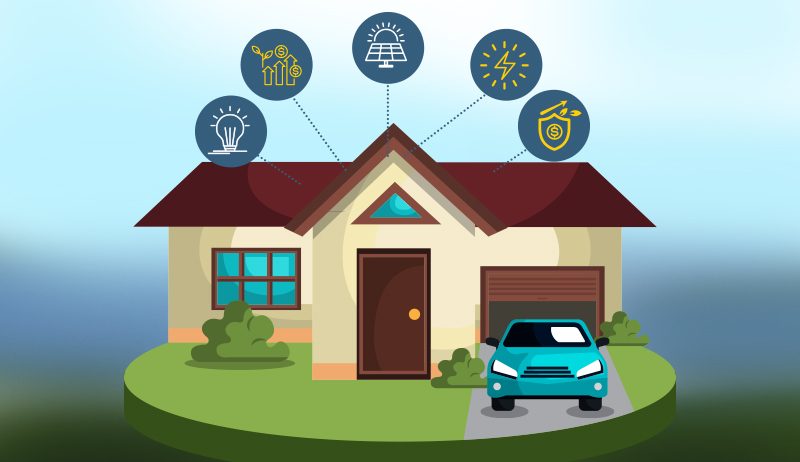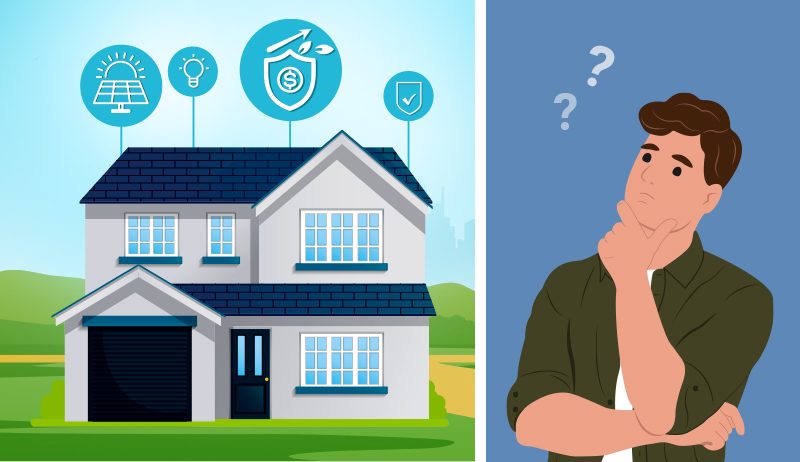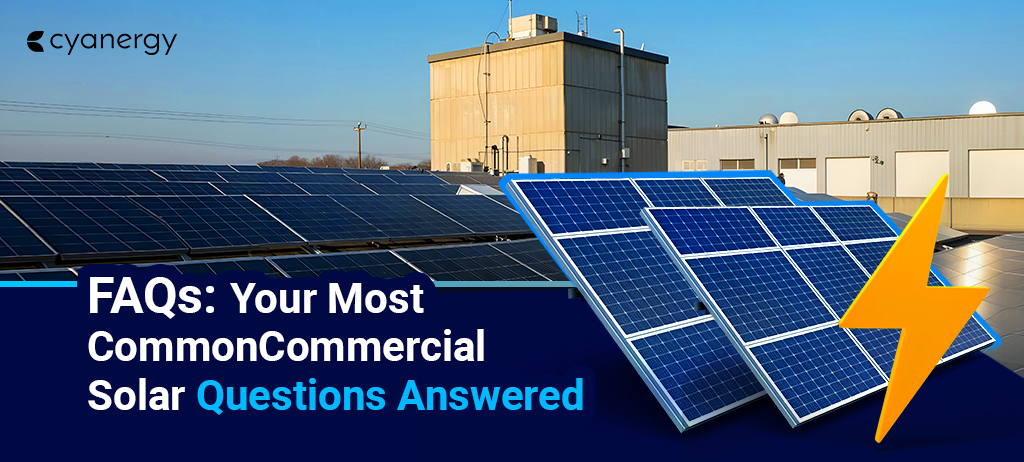Imagine a system that monitors your energy use and suggests clever ways to save money on electricity bills.
Precisely, that’s what a cost-efficient Home Energy Management System (HEMS) does. It makes your home more energy-efficient without breaking the bank.
It is a friendly assistant that makes your home both smart and budget-friendly. But What exactly is HEMS? And how is the home energy management system a cost-efficient approach? Let’s find out.
What is HEMS?
HEMS stands for Home Energy Management System. It’s like a smart helper for your home that keeps track of how much energy you use and helps you use it wisely.
It takes care of your appliances, lights, and heating. Likewise, it also ensures they work efficiently and don’t use too much electricity.
With HEMS, you can control things in your home using your phone or computer. It’s like having a remote control for your house! It can also talk to your smart devices, like turning off lights automatically when you’re not using them.
One cool thing about HEMS is that it can understand when energy costs less and suggest the best times to use appliances to save money. It’s like having a money-saving advisor for your electricity!
If you have solar panels or other renewable energy sources, HEMS can also help you use that energy wisely. It’s like having a little energy coach that tells you how to make the most of the clean energy your home produces.
In simple terms, HEMS is a smart system that helps you manage your home’s energy cleverly and efficiently, making your life easier and more eco-friendly.
Component and Key Feature of HEMS
A key feature of Home Energy Management Systems (HEMS) is their ability to monitor, control, and optimize energy usage within a residential setting.
Here are some key features of HEMS:
Real-time Monitoring:
Sensors and Meters:
Energy Meters: These devices measure the overall energy consumption of the home.
Smart Plugs and Outlets: It has built-in sensors that monitor the energy usage of individual devices connected to them.
Smart Device Integration:
Cloud Services:
Energy Analytics:
Renewable Energy Integration:

Many HEMS solutions support the integration of renewable energy sources, such as solar panels or wind turbines. It allows homeowners to monitor and maximize clean energy generated on-site.
Solar Panels: Solar energy converts sunlight into electricity, providing a clean and sustainable power source for the home.
Wind Turbines: Devices that generate electricity from wind energy.
Load Shifting and Peak Demand Management:
Smart Appliance Control:
It may involve setting temperature schedules, adjusting settings remotely, and integrating with weather forecasts for optimal comfort and energy savings.
Smart Thermostats: These devices control the heating and cooling systems and optimize temperature settings for energy efficiency.
Smart Lighting: Energy-efficient LED lights and smart switches can be remotely controlled.
Smart Appliances: Devices such as refrigerators, washing machines, and ovens that can connect to the HEMS for optimized energy usage.
Energy Storage Management:
For homes with energy storage solutions, HEMS can manage the charging and discharging of batteries. This ensures efficient use of stored energy and provides backup power during grid outages.
Solar batteries or other storage devices store excess energy generated by renewable sources like solar panels for later use.
User-Friendly Interfaces:
HEMS features user-friendly interfaces, typically accessible through mobile apps or web platforms. These interfaces allow homeowners to monitor energy usage, receive alerts, and control devices.
Mobile Apps: Applications that allow users to monitor and control their HEMS from smartphones or tablets.
Web Interfaces: Online platforms that enable remote access and control of the HEMS from computers or other internet-connected devices.
Automation, Control Logic and Scheduling:
Remote Access and Control:
Security Measures:
Features such as encryption and authentication protocols ensure data security between HEMS components and user interfaces.
HEMS creates a smart and interconnected system that empowers homeowners to manage their energy consumption efficiently. It also reduces costs and contributes to a more sustainable lifestyle.
Technical specifications

To successfully implement a Home Energy Management System (HEMS), specific technical specifications must be fulfilled to guarantee the smooth and consistent operation of various distributed energy resources (DERs).
A stable internet connection is essential for effective communication among the Energy Management System (EMS), server, and each energy device. While having a secure local network is sufficient, an internet connection ensures optimal performance.
A local gateway or hub typically works as a central control unit like our grid box, crucial for optimizing energy flows on-site. Alternatively, cloud-based energy management is feasible without a local gateway, although it is less common and may result in increased latency.
Additionally, the software and applications must be compatible with the hardware to efficiently control, monitor, and access the distributed energy resources within a household.
Why Should We Get A Home Energy Management System? Benefits of HEMS
In Australia, where there’s a lot of sunshine, having a Home Energy Management System (HEMS) is a smart choice for homes that want to be eco-friendly and efficient.
Think of it like making your home work well with nature and using the sun’s energy wisely.
Australia has different weather in various areas, so having a HEMS helps manage energy usage. Imagine a home where every bit of energy is used carefully to meet people’s needs without wasting any.
It is crucial in a country where energy prices can change, and caring for the environment is more than just a trend.
In the hot summers of places like the Outback or the cooler coastal regions, a HEMS helps keep homes comfortable without using too much energy.
It’s like a guardian making sure the air conditioning works just right. It helps keep homes warm in the colder months without using too much energy and preserving resources.
Think about relying on your home for energy, especially in areas with lots of space and faraway homes.
A HEMS makes homes more independent, using solar panels and not needing the usual power grid. It’s a significant change that makes homes more resilient and self-sufficient, even in remote areas.
Using a HEMS in Australia is not just suitable for homes; it’s good for the environment, too. Australia is committed to fighting climate change and making a green future.
When homes use HEMS, they become part of a more significant effort to protect the environment. Each home is a small example of sustainability, adding up to make a significant impact.
So, getting a Home Energy Management System in Australia isn’t just a fancy technology for homes. It’s a powerful tool for change.
It’s about making homes work well with the sun, bringing sustainability into everyday life, and moving towards a future where we use energy thoughtfully and responsibly.
Differences Between Home Energy Management Systems and Energy Monitoring Systems

Home Energy Management Systems (HEMS) and Energy Monitoring Systems (EMS) do different jobs to help homes use energy better. Even though they both make homes use energy wisely, they are different.
HEMS is like a smart helper for your home. It watches how much energy your home uses and helps control and manage different energy things in your house.
On the other hand, Energy Monitoring Systems (EMS) focuses on monitoring how much energy your home uses.
They use an energy meter and sensor data to show which devices use energy most. EMS helps you see where your home uses a lot of energy so you can make smart choices.
Unlike HEMS, EMS doesn’t have as much control over devices or the ability to save energy automatically.
In short, the big difference is in what they do. HEMS actively controls and manages energy-based devices. It works with smart devices to make your home use energy in the best way.
However, EMS tells you about your energy use patterns. It assists you to make good decisions to use less energy. Both are important for making homes use energy wisely, just in different ways.
Go to Cyanergy for energy-efficient products for residential and commercial purposes.







